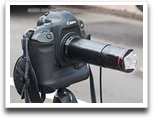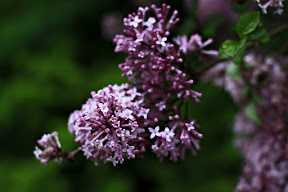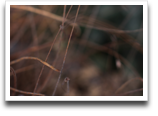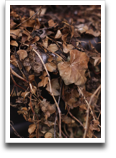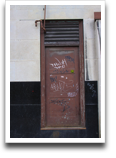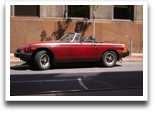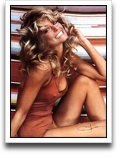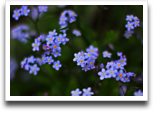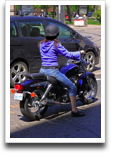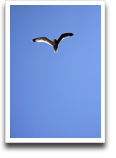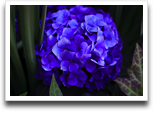This journal documents my experiences with a Canon 50D, my first DSLR camera, purchased on Oct. 16, 2008. It is a showcase for my photography, includes comments about the camera's usability, with suggestions for improvement and discusses photography-related topics.
Aaaaaah! My Eyes!
equipment
Mon Jun 01 00:00:08 2009
When they hand out Pulitzer prizes, the judges
never ask what kind of camera the image was shot with, or whether
it was shot on film or digital!
—Karl Grobl
Eric sent me a link to Karl Grobl's site where the wear and tear
(literally) on his camera equipment is well documented.

Bing
technology
Mon Jun 01 14:51:05 2009
I tried out Bing, Microsoft's search engine, today; I searched for
"The Photography Book".
Bing gave me Scott Kelby's book on Amazon (.COM not .CA, even though it knows and makes a big deal that I'm searching from Toronto); Google gave me the correct answer.
Google has no worries.

Old Man and the Seagull
photo
Tue Jun 02 13:20:27 2009
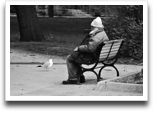 |
24-105L @ 105, High-speed, Aperture Priority, f/4, 1/200s, AWB, AISO. Cropped (rule of thirds; man's head is the focal point followed by the bird), contrast adjusted, unsharp mask [1 of 6]. |
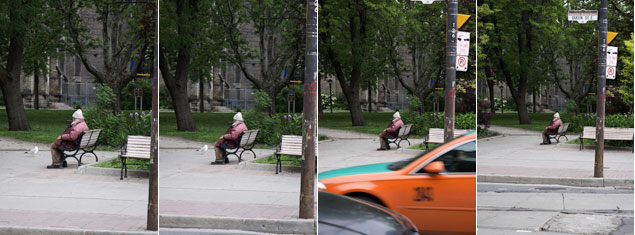 |
This sequence of photos shows the original aspect ratio and field of view, from which the final photograph was obtained.
|
The chosen photograph is a crop of the first of 6 photographs (2 deleted images were identical duplicates shot in high-speed) taken from across the street, in portrait mode, starting at 105mm and zooming out to 55mm. The man is a regular at the parkette on Church and Queen, except on rainy days.

70-200mm f/2.8L IS
gear
Wed Jun 03 00:29:14 2009
I've been checking the price of this lens, at Vistek, for the past week and suddenly, a few moments ago, I noticed that it's $100 cheaper ($2,149).
Why?! Is it a return? Does it have a defect? Is there a problem with it? Is it the increase of the Canadian dollar? Should I buy it now or wait for the price to drop further? Will the price go up?
It's probably likely the Canadian dollar as the f/4 is $40 cheaper
($1,419) than the regular price.

Avril Cutout
photo
Fri Jun 05 12:19:12 2009
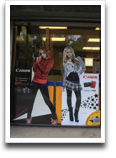 |
The promotional material for the Canon Rebel
at Downtown Camera on Queen street, photographed from the
sidewalk. |
The one on the left is last year's ad; the one on the right
appeared last month, I think. It replaced a duplicate of the one on the
left.

Self-portraits with Raindrops & Leaves
photo
Fri Jun 05 12:59:58 2009
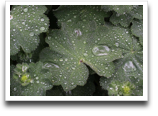 |
50mm f/2.8 |
No one notices the self-portraits until I point them out. I
guess it was too subtle or people aren't as observant as I am.

Pico Projectors
technology
Fri Jun 05 22:05:26 2009
Last month I wished that my 50D had a mini projector built-in to
it. Well, as they say, "we have the technology".
What is scary, is that all my wishes have come true.

Luminato
photos
Sat Jun 06 10:39:32 2009
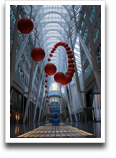 |
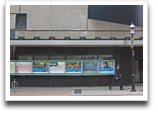 |
Luminato sculpture at the BCE Place galleria. |
Neil Gaiman poster at the St. Lawrence
Center for the Arts. |
The Luminato festival is taking place this weekend in Toronto. The pixelboard at the St. Lawrence Center for the Arts reads, "An Evening with Neil Gaiman, Jane Mallett Theater, June 8 at 7:00PM. Join the author of Coraline for the Canadian debut of his new novel, The Graveyard Book".
The Binary Waves Luminato sculpture along Bay at the Commerce Court, whose setup began Wednesday morning, was being dismantled when I walked by Friday evening; everyone was looking rather grim.

D-Day
photos capa
Sat Jun 06 11:41:52 2009
LIFE Magazine has a slideshow of photographs (some of them in colour) leading up to the invasion of Normandy, on the Day of Days.
I was surprised to read, in one of the captions, that most of Capa's photographs were lost
in a darkroom travesty, after they were sent back to London.
This is reason enough to say good riddance to film and all those chemicals.
Sat Jun 06 19:58:05 2009: By a strange coincidence, never before seen colour photographs of the "private life of Hitler", taken by his personal photographer, Hugo Jaeger, were published by LIFE.
I wondered what camera (and film) he used; the best I could do was to find a discussion about colour film processing in the late 1930s— in 1936 Kodak introduced Kodachrome; in 1937 Agfa introduced Agfacolor-Neu (which could be developed at home, compared with Kodak's process which had to be done in Kodak's lab because it involved 28 steps).

Uncanny
photo
Sun Jun 07 11:07:59 2009
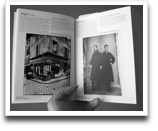 |
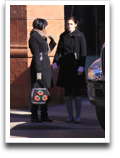 |
Pages 28 and 29 of The Photo Book |
Photograph taken in Feb. 2009. |
The photograph on page 29 is by Jane Atwood, taken in 1980; it is titled Blind Twins, Saint-Mandé, France. Comparing the two photographs, we have long, dark overcoats, Wellington boots, and only one of them is wearing a scarf.
I have never seen the Atwood photograph of the twins before; the closest picture to that, would have been the twins photograph by Diane Arbus (IIRC) which was an inspiration for the twins in Kubrick's The Shining.
I just realized that the photograph on the facing page is titled, Cabaret, Rue Mouffetard, a street name mentioned in the opening narration of the film Amélie.

60D Rumour
technology
Tue Jun 09 13:38:30 2009
Canon
Rumours is reporting a 60D which is a 50d with HD video
(DIGIC V) and SD cards instead of CF.
I wondered why Apple dropped the Expresscard slot for an SD card
slot in yesterday's Macbook Pro announcements. I wondered if they
had some insider information.

Portfolio: Luigi Bussolati
photographer
Thu Jun 11 15:03:47 2009
Diverse styles
of photography (Flash
required) with a great eye for composition.

Friday Foto
photo
Fri Jun 12 16:39:13 2009
Taken with the 24-105mm in the plants in the traffic median on
Front street opposite Union Station.

Red
photos
Sat Jun 13 09:37:06 2009
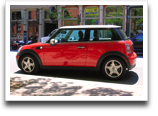 |
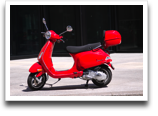 |
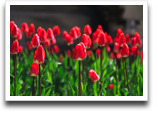 |
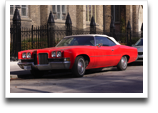 |
Mini Cooper on Front St., near the Flatiron. |
Vespa in front of the Royal Bank [1 of 2] |
Tulip bed next to St. James' Cathedral [1 of 3] |
"Red Shark" at St. Michaels Cathedral (crop, 50mm, Oct. 2008) |
In this second of two photographs I took of the Vespa, I underexposed the glass in the background so it was as close to black as possible, by metering on the mirror and then recomposing. The first photograph was metered on the black seat which brightened the background, adding an unnecessary distraction.
The tulip bed was my first "backlit" photograph of flowers which made me realize what a nice effect you can get photographing flowers that are lit from the back by a late morning sun, in front of a background in deep shadow.

Friday Foto Picasa Album
photos
Mon Jun 15 18:04:12 2009
I setup a Picasa Album for
my Friday
Foto mailing list; the subscribers, all staff members in the
department, receive a new photo every Friday.
The Picasa Album setup was surprisingly painless and the interface
is quite intuitive.

Stereographic Planets
photos
Tue Jun 16 16:17:35 2009
A nice collection of stereographic planet photographs including a
how-to at the end, which itself includes tips on shooting panoramic
photographs.

"Your camera takes great pictures"
philosopy
Wed Jun 17 00:09:08 2009
I've heard these so-called compliments a few times now— "Your camera takes great pictures," and "You have a more expensive camera so naturally your photos look better." These people seem to be under the impression that it's the camera that takes photographs. I am unable to persuade them that they are wrong.
It's true that a $200 camera cannot take pictures that look as good as a $2,000 camera in low light; as an extreme example, you can't take Sports Illustrated-quality photographs with an iPhone. Before the sensor sizes of the two cameras are compared, the biggest difference in the two cameras is the lens in front of the sensor; the lens on the $2,000 camera probably cost as much as the camera itself. A $200 camera however, can take snapshots that, when printed (4x6) will be indistinguishable from similar sized prints shot with a $2,000 camera.
The two things I do differently now, than when I was shooting with the Canon S30 and S60, is that I pay attention to composition— the 50D interface allows me to easily choose from 9 focus points— and to the aperture— the lenses I use are much better in this respect. I also have a much better understanding of the relationship amongst aperture, exposure and ISO. (It should be noted that with the S30 and S60, I could choose from 3 AF points but I never remembered how to do it when the time came.)
I think the biggest problem people have, is that they don't know how to operate their cameras (either because they don't care or the camera is too complicated). In comparison, I have read the 50D manual about 5 times in the eight months I've had the camera; I never read the S60 manual and I probably glanced through the S30 manual a couple of times.
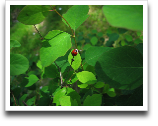 |
This photo was taken with the Canon S60. I would classify this as my best photograph with the S60 taken in the Macro scene mode. Had I known about the Rule of Thirds at the time, the ladybug would not have been centered. [1 of 1] |
Wed Jun 17 09:22:53 2009: With both the S30 and S60 cameras, I photographed in Program mode and switched to Shutter Priority (Tv) when I needed to do a long exposure. I didn't really understand Aperture Priority (Av); now, of course, I mostly shoot in Av. I don't know whether it would have helped to know what I know now, when I was shooting with the digicams. Without question, my photos would have been better composed, if I had known about the Rule of Thirds.
Wed Jun 17 23:50:25 2009: So, in response to the non-believers, I urge them to find out what conditions their current camera takes the best pictures in, and try to establish those same conditions, whenever possible, before taking a photograph.

3GS Camera
photos
Wed Jun 17 15:50:13 2009
Andy Ihnatko's Flickr photoset taken with the iPhone 3GS' camera (an f/2.8 lens means that now, low-light, indoor photography is possible with the iPhone).

Cheap Lenses
gear
Thu Jun 18 00:12:31 2009
For all those people who have a difficult time believing that lenses are more important than the camera body, I present The Canon 1Ds pinhole camera with the "L" lens made from toilet-paper tubes.
Update Thu Jun 18 18:51:54 2009: David responds:
A good lens will last you a decade or more (typical warranties). Most dSLR
bodies are "out of date" in about two years:

OK, listen up. The most important component of your camera is the lens. If there is a place to spend the money, it's on the glass. I'd take a 5 year old 20D with a good lens over a top of the line 1Ds MkIII with a crappy lens any day of the week. I can't tell you the number of people I see who have this all wrong.
Last year at the Grand Canyon, I saw a girl with a high-end Gitzo tripod, 5D body, and some crappy consumer level zoom lens on the front. Honestly, I almost pushed her over the edge.
—Glass (part one)
BUILT Camera Bag
gear
Thu Jun 18 18:50:11 2009
Stylish and unique-looking (meaning, doesn't look like a typical camera bag) camera bag from BUILT who also make various other sizes of camera bags.

Friday Foto
photo
Fri Jun 19 16:35:07 2009
I don't remember which park I took this photo in. Taken with the 24-105mm.

Canon 1D MkIV Rumoured Specs
Fri Jun 19 11:14:58 2009
Detailed specs (subject to change on the final production model)
of
the 1D
MkIV camera being secretly tested. It looks like it might have
real AF in LiveView rather than the currently ass press-a-dedicated-button-to-auto-focus.
I am considering upgrading to one of the 1D models rather than a 60D, if only for the weather-sealing. I would like to be able to shoot in all kinds of weather in downtown Toronto, not in some inhospitable third-world country.

Brown
photos
Sat Jun 20 00:17:23 2009
I thought that a photo essay with a brown theme would have been a difficult colour to photograph in Toronto; instead, it was easier than I imagined.
I am having great difficulty photographing "blue".

Sidearm
technique
Sat Jun 20 23:19:18 2009
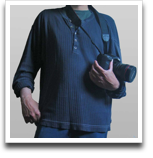 |
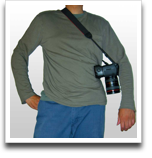 |
My old camera carrying technique. To relieve the nexk strain, I supported the lens in the crook of my arm which became sore, requiring me to switch the camera to the other arm. |
My new camera carrying technique has the camera supposted on my shoulder and hip. The camera is shown with the battery grip and the 24-105mm lens attached. |
Until recently, I carried my camera with strap around my neck, cradling the lens in the crook my arm with the body against my hip. I wasn't too keen on this technique because the lens stuck-out and a passer-by moving past me quicky, could potentially bump into it. My carrying-arm also got tired cradling the camera, requiring me to switch arms. I used this technique because it allowed me get the camera into shooting position very quickly.
If I needed to walk briskly, I would put the strap over my shoulder and the camera would rest in the small of my back with the lens sticking out perpendicular to my body. I had to be cautious when passing through doors and when my back was close to a wall.
The new technique, has the strap resting on my shoulder with the weight of the camera and lens resting on my hip. My arm rests on the hotshoe, keeping the camera from shifting and the lens-down position keeps the lens protected. I think this carrying technique will also work well with the 70-200mm lens.
The camera bag is across the other shoulder on my other hip.
Sun Jun 21 14:59:05 2009: David sends some additional
suggestions:
Recommended way by Ken Rockwell:
Sling your camera around your shoulder and neck. Now you can run, and if the camera's not already in your hands, just tuck it down with your elbow if you have to scramble.
There's at least one camera strap (the "R-strap") that encourages this position. Though there are some things people don't like about it that they're trying to work around.
Sun Jun 21 15:36:20 2009: Updated with a "before" photograph.

Kodachrome, R.I.P.
technology
Mon Jun 22 17:03:47 2009
Kodak has announced that it is ending production of Kodachrome film.
By a peculiar coincidence, I unsubscribed from The Online Photographer's RSS feed just yesterday because of his excessive whinage about pretty much everything; I can only imagine his post on this topic.
Also conincidentally, I got to the end of The Photo Book (review to appear soon), which lists all the past photographic print techniques, beginning with the Heliogravure in the 1820s.
Mon Jun 22 20:55:25 2009: I don't understand the nostalgia
towards Kodachrome. I wonder if photographers looked back at
Calotype in equal nostalgia when it was supplanted by
Daguerrotype. Will we look back at at grainy ISO 3200 JPEGS and RAW
files when they are replaced by fully immersive holographic
video?
Tue Jun 23 20:48:51 2009: David responds:
> I don't understand the nostalgia towards Kodachrome.
I think it's more like an Irish wake, where you remember all the good times you had with the person. The quantity and quality of historical events that were captured for future generations by the film is astounding.
Also, given that the film was developed in 1935, and wasn't (arguably) surpassed until perhaps 1990 (Fuji's Velvia), is also a testament to the quality of the product.
I think that dSLRs are finally approaching (or even surpassing) the quality of film (this month is the ten year anniversary of the first dSLR--the Nikon D1), but it took a while, and even now a lot of prints are of so-so quality from a signal-to-noise perspective. People also find it easier to preserve a shoebox full of photos than learn how to backup their iPhoto or Picassa libraries.
> Will we look back at at grainy ISO 3200 JPEGS and RAW files when they
> are replaced by fully immersive holographic video?
Images and video are different media, with different characteristics (cf. Marshall McLuhan). What you want (and can) convey and accomplish is different between the two. (Just as painting and theatre (nee cinema) are different.)
Your statement also seems to imply that newer is always better.
It's also perhaps more of a qualitative issue to some extent: you can certainly shoot off (and carry / store) a thousand images images with digital a lot easier than a thousand on film. But given the higher "overhead" and costs for film, it perhaps lends itself to a more contemplative endeavour to capturing moments of time, as implied in the following quotation:
With type as with philosophy, music and food, it is better to have a
little of the best than to be swamped with the derivative, the careless,
the routine.
—Robert Bringhurst, "The Elements of Typographic Style"
In general I think people are not necessarily being nostalgic, but simply reminiscing. This event is giving them an opportunity / excuse to go back and reflect on history--both their own and the world's--as captured through Kodacrhome.
The implication that newer is always better came from having read about, in The Photo Book, all the photographic techniques that preceeded, digital film; e.g. there was one colour format, Vivex, that lasted only a decade (somewhat akin to 3.5 inch floppy disks). But David is right, newer is not always better, if we recall that still-born APS format (I don't recall anyone mourning the death of that abomination).

Photoshoot: Award Ceremony
photos
Tue Jun 23 21:17:44 2009
I had a photoshoot today of an award ceremony and a reception.
I used the 24-105/4L lens and shot (partial metering at ISO 1600, Landscape scene style) a total of 205 photos which were reduced (after 3 hours of work) to 79, of which I used 41 (including the banner images) in the photo album.
The 24-70mm f/2.8 would have definitely come in handy for the low lighting in the auditorium as would the 70-200mm for closeups. I would have needed two bodies though, because I wanted to get crowd-reaction shots in addition to close-ups of the speakers; there would be no chance to change lenses.
The closeups in the day-lit Auditorium where the reception was held are amazingly beautiful. I had to fix a few of the images shot against the white background, because the lighting was coming from a sharp angle, casting shadows on the faces and throwing off the metering. Looking over the album, there are still a few photos I need to fix (using fill-flash and spot-metering would have helped). I'm not accustomed to photographing people, so I use these opportunities as a learning experience.
I only included the first photograph because it shows the muted colours of Portrait mode scene style (IIRC, I have to double-check); the other photos have the vibrancy of Landscape scene style.
Wed Jun 24 09:28:52 2009: I should say a few words about technique: I managed to get candid shots of the group on stage because I waited for the punch-line to the speaker's humourous story and shot in high-speed when the punch-line was delivered. Taking a cue from HCB, since I knew it would eventually come, I just waited for it.
Also, the university photographer was there shooting away with his Nikon and flash during the ceremony. Later, I was told, that there was a question asked about why I wasn't using a flash. My boss replied to the effect that "If the person knows what they're doing, they don't need flash." That was not entirely the truth because he was shooting for print and I was shooting for the web; I don't think my ISO1600 shots, which look great when down-sampled, would have looked as great in print as his shots.
Wed Jun 24 22:26:56 2009: For some reason (actually, the reason is because I wanted to shoot f/8 so I switched to my C1 preset which is used for landscape photography), probably fatigue— both mental and physical— I shot the last few photographs in Landscape scene style. Note: Do not ever photograph people in Landscape style because the amount of work required to later fix the photographs is painful.

Farah Fawcett, R. I. P.
Thu Jun 25 13:35:47 2009
Farah Fawcett passed away today, aged 62. She was unforgettable
for
her pinup
poster. I didn't realize that, "If you looked closely at that
poster, which Fawcett posed for in 1976, you could make out the
letters SEX formed in her hair."
The photographer was Bruce McBroom; I just found out that he's
also
a cinematographer.
Freelance photographer Bruce McBroom had worked with Fawcett before, so Pro Arts agreed to hire him for the shoot. They wanted a bikini shot, but Fawcett chose the red one-piece swimsuit to cover a childhood scar on her stomach.
They shot the photo by the pool at the Bel Air, Calif. home she shared with her husband at the time, actor Lee Majors, TV's "The Six Million Dollar Man."
She did her own hair for the shoot. The backdrop is an old Indian blanket the photographer was using to cover the seat of his old Chevy.

Photo Curtain
Thu Jun 25 23:52:42 2009
Printing a photograph on
a shower
curtain sounds like a great idea, but it ultimately depends
on how the chosen photograph looks when enlarged 2000 percent.

Friday Foto: Exotic Plant
photo
Fri Jun 26 16:17:24 2009
Today's Friday Foto is an exotic decorative plant at the entrance
of the Jazz residence.

EF 70-200 f/2.8L IS
gear
Sat Jun 27 10:17:55 2009
I checked the price of the EF 70-200 f/2.8L IS this morning and
Henry's has it for $1900!!!! (though not in stock) while Vistek is still
selling it for $2149.
I promised I wouldn't buy from Henry's, but this is tempting...

Rumoured 24-70 f/2.8L IS
Sat Jun 27 14:20:50 2009
"It IS about time."
Canon Rumours is reporting on the very likely possibility of a 24-70/2.8L IS lens. I have been eagerly anticipating this lens. If I'm going to haul around a heavy lens, then it better be Image Stabilized. I cannot imagine buying a non-IS lens any more.
If it comes to fruition, then 24-70/2.8 IS, will complement the 70-200/2.8 IS, thus giving a pair of f/2.8L IS lenses that provide a full range of coverage from 24mm to 200mm— approximating 10x zoom.

Blue
photos
Sun Jun 28 12:06:03 2009
Blue is not a popular colour in downtown Toronto. There are blue awnings— The King Edward Hotel, and Young Thailand restaurant— some blue cabs, but otherwise, the city is bereft of blue. Yellow seems to be the most popular color in the city.

Review: "The Photography Book"
book review
Sun Jun 28 17:31:02 2009
My
review of The Photography Book. I rated it 2.5++ out
of 4.
















